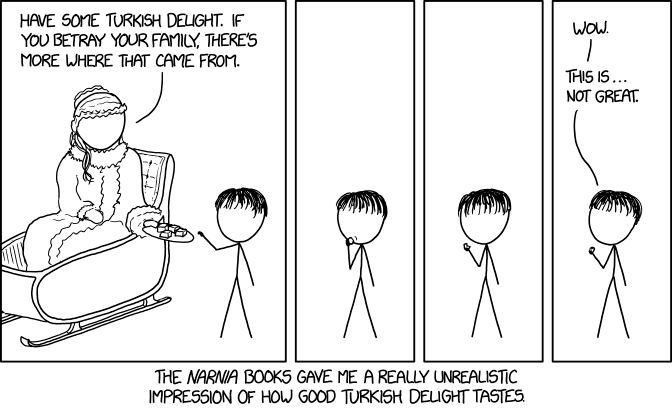Turkish Delight

I take it Narnia doesn't have Cinnabons? Because if you can magic up a plate of those, I'll betray whoever.

I take it Narnia doesn't have Cinnabons? Because if you can magic up a plate of those, I'll betray whoever.
The Lion, the Witch and the Wardrobe is a fantasy novel by British novelist C. S. Lewis, the first published and best known of seven novels in The Chronicles of Narnia. In it, a group of four sibling children discover another world called Narnia. At the beginning of the story, the land is in a perpetual winter caused by the White Witch (the antagonist of the story). One of the children, Edmund Pevensie, is approached by the White Witch and offered Turkish delight, a type of confection, in exchange for leading the other children to her. What the book says and what the movie leaves out is he doesn't know the sweets are enchanted by the White Witch to make the eater want them the more they eat them. Not a full mind control, but more of a strong urge to get more.
Turkish delight is very different from typical confections found in the modern Western world and isn't very popular in the United States. The primary flavoring agent of Turkish Delights, rosewater, has a strong perfume-like taste and is generally considered an acquired taste for western palates. Randall, who has made comics about being unimpressed by food in the past, comments that he was very disappointed when he tried Turkish delight, especially after having read in the novel about how delicious the characters considered it. If he were in Edmund's shoes, he would not have been persuaded.
It is not uncommon for present-day Narnia fans to be disappointed when they try Turkish delight, as different as it is to modern confections. However, in the late Victorian era when Lewis grew up, Turkish delight was very popular in England. Because it was nearly impossible for local confectioners to make properly, it had to be imported from Turkey, at great expense, making it a status symbol for the wealthy and a rare treat for those with less money. When Lewis wanted to come up with the perfect temptation for Edmund, he drew on his own childhood memories of a favorite rare and expensive treat--which would have been even harder to come by because of sugar rationing during World War II, when the story was set. It also serves to emphasize how powerful the White Witch is for her to be able to offer such an expensive and hard-to-obtain treat so easily.
Cinnabon (referenced in the title text) is a popular chain restaurant in the USA which serves mostly cinnamon buns covered in a thick, sugary glaze. The chain is not well known in Britain, but has recently opened a few restaurants, mainly in the London area. (A more common UK equivalent of the cinnamon bun is the Chelsea bun.) There are presumably no branches of Cinnabon in Narnia.[citation needed] Randall is saying that he finds cinnamon buns delicious, to the point where he would betray anyone for them. It should be noted that, in the books, it was Edmund who requested the Turkish Delight, implying that they're his favorite treat. Thus, had it been Randall instead of Edmund, he very well could have requested cinnabons.